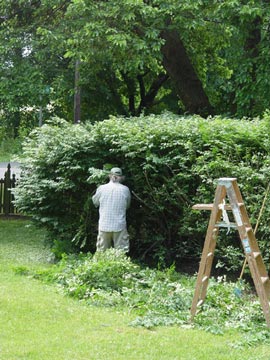Pruning can sometimes seem like such a destructive thing, perhaps too severe. Many a bush or tree never gets trimmed for that very reason. Plus there’s concern that cutting will kill or harm a plant, and so people “let well enough alone” and do nothing. The truth is that pruning – when done in the right way and at the right time – is a good and necessary part of yard care.
 Plants can benefit from pruning, but fall isn’t the time to do it.
Plants can benefit from pruning, but fall isn’t the time to do it.
Left to their own devices, woody plants often put out too much growth for their own good. They may grow overly dense foliage that doesn’t dry well, resulting in leaf disease. Or limbs can cross and rub, opening wounds that lead to infection. Or aging shrubs such as mock orange or lilac stop blooming and become more disease-prone because more vigorous young growth is being blocked by old wood. Pruning can help solve each of those and benefit the health of the plants. More often than not, though, pruning is needed because plants are simply outgrowing their assigned space. Or they’re just getting too big or too rangy for the gardener’s taste. The tricky part is that not all plants should be cut in the same way.
Evergreen hedge plants, such as boxwoods, yews, and hollies, are fine with shearing. They’ll just grow new leaves on all of the trimmed branches. Dense flowering shrubs, such as spireas, shrub roses, and abelia, also respond well to shearing. But trees, tall shrubs and most other flowering shrubs prefer selective cuts – ones made one-by-one with hand pruners or loppers to take out the crowded, crossing, old or damaged wood.
When to prune is also important. The worst time to prune is late summer into fall – the very time that a lot of gardeners decide to prune after seeing a season’s worth of growth. Heading into fall, plants are preparing for winter. They’re slowing growth, “hardening” their branches to withstand cold, and in the case of spring bloomers, forming flower buds for next year. Whacking plants then disrupts that process. Slowing plants kick back into growth mode instead of preparing for winter. Wood left behind often attempts to push out new growth, now that it’s suddenly on the “front line.” However, that growth often doesn’t harden in time for winter and ends up dying. And by cutting spring bloomers in fall, you’ll remove much or all of the flower buds that would’ve bloomed next year.
A good rule of thumb is to wait to prune spring-blooming trees and shrubs until immediately after they’re done blooming. This includes spring blooming favorites like azaleas, lilacs and rhododendrons. Woody plants that bloom in summer (butterfly bush and rose-of-sharon for example) can be pruned at winter’s end since they’ll form flower buds on that season’s growth. Shrub roses are best pruned in early spring just before new growth begins, while evergreens are best pruned between the end of winter and mid-summer. Shade trees and others not being grown for their flowers are ideally pruned in winter while the branches are bare.